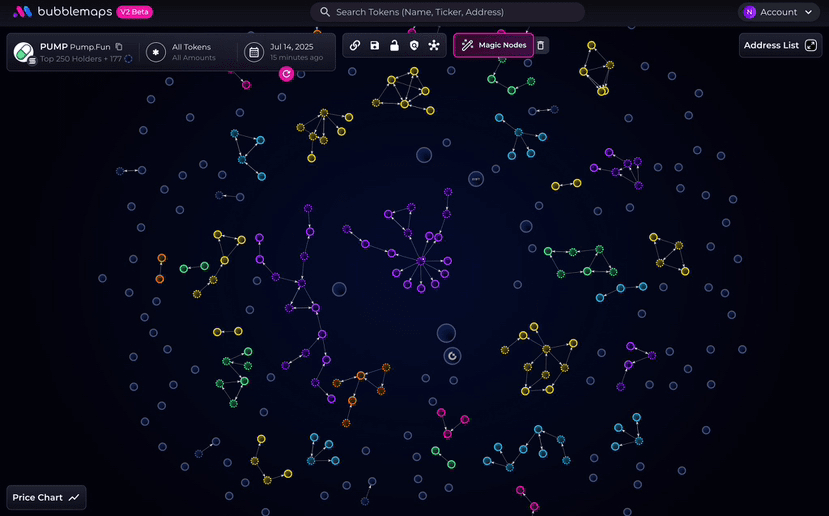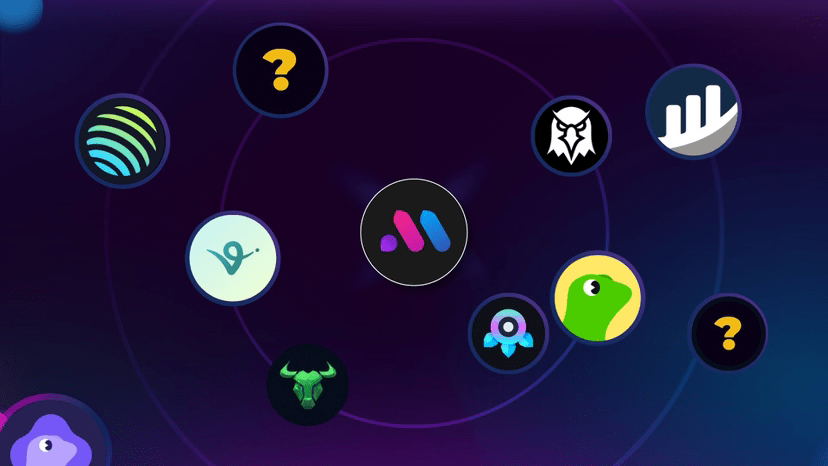Why is this tool so powerful?
Imagine traditional blockchain visual tools often consist of dense transaction lists and rows of data, which can be overwhelming. Bubblemaps is completely different—it turns this complex data into bubble maps. Each 'bubble' represents a wallet, and the size of the bubble indicates the amount held; lines between bubbles represent token interactions. This graphical representation reveals information like 'who holds a lot' and 'which wallets collude' at a glance.
Regarding online investigations of DeFi and NFT projects, Bubblemaps has been used several times, quickly exposing cases like LIBRA and MELANIA.
Core feature: Easy to use and intuitive, allowing you to quickly understand complex data.
Magic Nodes
This feature is quite clever, able to automatically identify wallets that seem unrelated but behave consistently. They may be behind a trading group or core team. This clustering mode cannot be seen with traditional tools.
Time Travel
Want to check project distribution and when unlocks happen? This feature allows you to rewind time to see when a token unlocks, which wallets take the opportunity to enter or exit, and how teams or large holders operate—all becomes clear.
Multi-chain support + in-depth analysis
Not just Ethereum, it also supports multiple mainstream chains like Solana, BNB Chain, Avalanche, Fantom, Arbitrum, Base, etc., making cross-chain analysis simple.
Intel Desk: Community survey platform
This might be my favorite feature. Users can submit suspicious projects, and a voting mechanism decides whether to investigate further. If the community wants to check someone out or thinks someone is up to no good, they can vote to produce an investigation report, truly achieving 'community audit'.
The team's fundraising background is also impressive.
The founders of Bubblemaps include Nicolas Vaiman, Arnaud Droz, and Léo Pons, and the team has a background in blockchain security and solid expertise in visual analysis.
The backing capital lineup is also quite solid: Consensys, INCE Capital, Momentum6, Polygon, Avalanche, Linea, Aptos, Fuel, Ledger, Sandbox, etc., have all provided strong support. This endorsement reassures people that it's not just a fleeting tool.
It also collaborates with many mainstream tool platforms: Etherscan, DEXScreener, CoinGecko, Pump.fun, OpenSea Pro, etc., integrating Bubblemaps so you can conduct on-chain analysis without switching between multiple tools.
What is the BMT token used for on the platform?
Unlock advanced features: such as Magic Nodes, Time Travel, P&L calculations, and even AI analytical capabilities, these are only available to BMT holders.
Governance rights & community voting: Proposals, voting, and reward mechanisms for Intel Desk all rely on BMT to drive them. Active community members can also earn token rewards. Airdrop mechanism: BMT rewarded early users with airdrops during the V2 release—providing benefits to those who participated in testing.
The total supply is 1 billion tokens, part of which is distributed as airdrops, and is also allocated to the team, ecosystem, investors, and liquidity, with overall distribution being transparent and clear.
Market performance: What is the current situation?
According to the latest data from BTCC, the current price of BMT is about 0.086 USD, with a 24-hour trading volume of approximately $19.8M and a market cap of about $32.9M. The historical high reached 0.286, while the historical low was about 0.0724.
Data from StealTheX also mentions that BMT rebounded from 0.081 USD at the end of May to about 0.1479 USD in mid-June, an increase of nearly 80%.
Pros and cons: Is it worth paying attention to?
Advantages:
Completely visualized, low threshold, easy to understand and check.
Community co-governance mechanism, with Intel Desk to make the platform more transparent.
Multi-chain coverage + integration with mainstream platforms means it's easy to use.
BMT's functionality is clearly defined—the unlocking feature also makes holding positions more meaningful.
Risk points:
Strong tool dependency; if UI/UX or features lag behind, it may be surpassed by other platforms.
BMT price is volatile, and speculators can easily lead the trend.
If community governance is not managed properly, it may become 'a crowd-pleasing gimmick' and become ineffective.
The market is highly competitive, with tools like Nansen, Dune, Arkham also doing on-chain analysis.
Bubblemaps, who is it suitable for?
It is particularly suitable for traders conducting 'pre-listing due diligence', or community analysts and researchers, providing a clear visual representation of the project's team or whale distribution; also suitable for risk control, auditing, or compliance roles, allowing quick assessment of abnormal fund flows; it also facilitates content creators to produce visually impactful content exposing manipulated projects.
In a nutshell: Bubblemaps transforms on-chain analysis from 'cold data' into 'intuitive maps', allowing you to explore investment risks like looking at a map.


